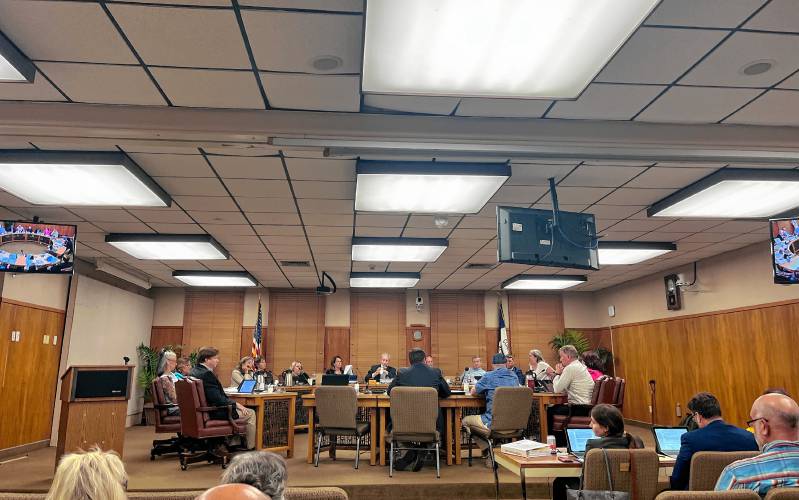Phenix Hall redevelopment clears major hurdle as City Council eases height restrictions

Concord City Council added flexibility to the maximum height rules on Main Street, after a developer whose project had been halted by the rules requested a change. Catherine McLaughlin—Monitor staff
| Published: 08-13-2024 3:33 PM |
Plans to rehabilitate the music venue within historic Phenix Hall, plus add housing, restaurants, and retail, took a big step forward Monday night as the Concord City Council agreed to allow new downtown developments to circumvent height rules on a case-by-case basis.
“I think we’re going to put forth a building that the city, the planning board and everybody can be proud of,” said Mark Ciborowski, the developer behind the plans, after the meeting. “I have no concerns about meeting the planning board’s guidelines.”
In the past, buildings downtown were only allowed to stand up to 80 feet based on existing rules that mandated the statehouse dome be visible to drivers along Interstate 93. But the new rule will allow new developments to add up to 10 feet more as long as they meet several conditions.
Without changes to the law, Ciborowski has said his $30 million project would not be financially feasible since it would mean cutting out an entire floor.
While the change means the project has cleared a massive hurdle, it must still meet certain criteria to be issued a conditional use permit. Ciborowski, and any developer in the future hoping to take advantage of the new flexibility, must prove to the planning board that the project blocks the statehouse dome as little as possible, makes “a positive contribution to the architectural character” of downtown and the skyline, and serves the community in some way — namely by improving the reuse real estate, cleaning a brownfield or other blight or adding 10 or more housing units.
Business leaders, fellow developers and abutters echoed to city council comments made previously to the planning board: The plans to make Phenix Hall usable again make them excited about Concord’s future, and they back the language making it possible.
“We’re talking about the ability on a case-by-case basis for a learned Planning Board to consider the merits, the pros and the cons, of every single project,” Jim Rosenberg, a lawyer and abutter downtown said. “In this case, the bright line rule that’s existed has prevented the very things that I think most of us, if not all of us ,would wish for: the rehabilitation of one of Concord’s most historic spaces.”
But the ability to get around those height and dome-visibility rules will be available to other projects, too — projects that, as at-large councilor Judith Kurtz said, “may not be as mindful” of Main Street’s history. Kurtz, and others, thought that the standards attached to a conditional use permit needed to be more clearly defined, ensuring the planning board had the power to block projects that run afoul of the city’s vision.
Article continues after...
Yesterday's Most Read Articles
 Concord may finally buy long-closed rail line with hopes of creating city-spanning trail
Concord may finally buy long-closed rail line with hopes of creating city-spanning trail
 New Hampshire targets sexual exploitation and human trafficking inside massage parlors
New Hampshire targets sexual exploitation and human trafficking inside massage parlors
 State rules Epsom must pay open-enrollment tuition to other school districts, despite its refraining from the program
State rules Epsom must pay open-enrollment tuition to other school districts, despite its refraining from the program
 New Cheers owners honor restaurant’s original menu while building something fresh
New Cheers owners honor restaurant’s original menu while building something fresh
 Remembered: Friends recall stories about the lives of those who died without housing
Remembered: Friends recall stories about the lives of those who died without housing
 A look ahead at the ‘preferred design’ for Concord’s new police headquarters
A look ahead at the ‘preferred design’ for Concord’s new police headquarters
“It’s not this project in particular, but I’m really worried that this is going to be a slippery slope,” Pam Sinotte said. She worried that projects with less preservationist intentions would, by getting these exceptions, dilute the character of downtown. “I worry it’s like this drip, drip, drip — this chipping away and before you know it things look very different.”
Members of the planning board and its design review committee said they wanted more oversight and objective standards for projects to meet.
Ward One Councilor Brent Todd, the council member on the planning board, felt that the language on the table had not met the “surgical” standard that the board had asked for, and said other board members agreed.
“We just want to make sure that the wording is tight enough that everybody at the table has clear guidelines,” said Claude Gentilhomme, a member of the Design Review Committee, which makes recommendations to the planning board.
The planning board gave the ordinance first review in April, made some suggestions for revisions and endorsed it unanimously. After city staff updated the ordinance’s language, the planning board opted not to review it again.
“I do think that the ordinance in front of us tonight is ready for prime time,” at-large Councilor Nathan Fennessy said. “If the planning board wanted to have a second bite at the apple, they should have said, ‘Bring the thing back to us before you send it on to the council.’”
In the end, the council unanimously endorsed a compromise: It approved the language and also referred it back to the planning board to suggest further changes.
“I would like to give Mr. Ciborowski some certitude,” said Mayor Byron Champlin. “I believe that by passing the ordinance, allowing him to start things in motion, he can put in his application. But at the same time, … [the] planning board can fine-tune it as they feel as they feel is necessary.”
There are two safeguards in the new language.
First, the planning board — the group expressing a desire for more caution — has the sole power to grant the exceptions, city manager Tom Aspell noted. Its members have the tools to say “no” to projects seeking this exception.
“That’s the discretion that you’re giving the planning board,” he said.
Second, in addition to board’s chance to ask for more changes, city councilors themselves will get another chance to change this zoning rule — and every zoning rule in the city. An overhaul of the city’s zoning code has been in the works for years but is currently on pause until the city updates its master plan. That process has no clear timeline, either, and some have criticized the city for allowing a developer to win spot treatments on its zoning language when the real solution has been sitting on the table.
Ciborowski said he was grateful for the chance to restart momentum of his project. The pause in the zoning overhaul “does make it difficult for developers to know where they stand, and move forward,” he said. “That’s why incremental steps like this are an important tool.”







 ‘A little piece of everything I like’: New Pittsfield barbershop brings more than a haircut to downtown
‘A little piece of everything I like’: New Pittsfield barbershop brings more than a haircut to downtown NH judge decides to pause Trump’s birthright citizenship order
NH judge decides to pause Trump’s birthright citizenship order Canterbury honors ‘real heroes’ with updated Military Veterans’ Project
Canterbury honors ‘real heroes’ with updated Military Veterans’ Project Look, up in the sky! It’s… an Airstream trailer?
Look, up in the sky! It’s… an Airstream trailer?
